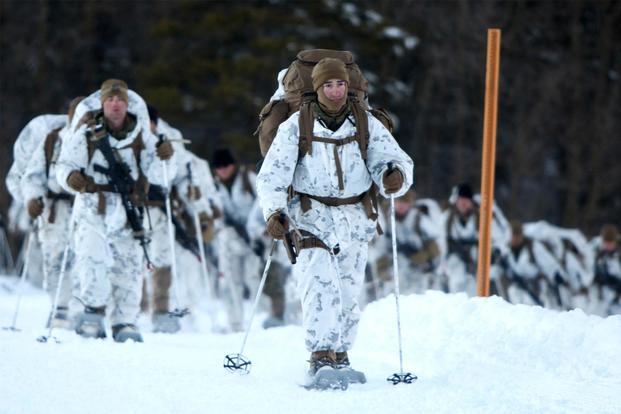MARINE CORPS BASE QUANTICO, Va. -- The Marine Corps wants new flame-resistant gear for leathernecks serving in cold climates as more troops prepare to deploy north of the Arctic Circle.
Marine Corps Systems Command officials issued a special notice this month advising vendors that they'll be on the hunt for flame-resistant, lightweight, cold-weather undershirts and drawers, according to notices on FedBizOpps.gov. Officials will "draft specifications and standards to accommodate a variety of design solutions and processes, and to encourage a broad vendor base," the messages states.
The notice comes just weeks after the U.S. and Norway agreed on a plan to rotate 700 Marines through Norway annually, starting next year. The Marines will likely train near the Russian border, something that has drawn sharp criticism from the Kremlin.
During the wars in Iraq and Afghanistan, Marine Corps began issuing flame-resistant organizational gear, or FROG clothing, to protect troops against improvised explosive devices and other burn hazards downrange. It's not immediately clear whether the service will seek other updated FROG apparel, aside from the drawers and undershirts.
Climashield, the company that designs the Corps' cold-weather sleeping bags and poncho liners, has developed a flame-retardant insulation the company displayed here during the Modern Day Marine Expo. The company's unique insulation is made of a continuous filament, so it doesn't pull apart, clump up or break apart like some other fillings.
"We're finalizing the development of that for outerwear," said Brian Emanuel, Climashield's general manager. "Based on what we've seen so far, we're confident we'll have a very competitive offering compared to existing technologies in outerwear."
The insulation can be used in coats and other outerwear, sleeping bags, gloves and footwear. It protects against "momentary exposure to flames and intense heat," according to product specifications.
Like the rest of Climashield's insulation, its continuous pattern means it stays intact without quilting or other stitching. That design not only cuts down on the weight of the outerwear, Emanuel said, but also helps keeps Marines warmer.
"When I was a kid, I started the winter with this jacket and, by the end of the season, all the filler was down at the bottom," he said. "Our insulation does not do that, simply because of the continuous filament structure. That minimizes cold spots."
As the Marine Corps drafts the specifications and standards it wants in new cold-weather FROG clothing, vendors are invited to review them and provide comments by Oct. 4, according to the FedBizOpps notice. The final document is expected to be posted here.
-- Gina Harkins can be reached at gina.harkins@military.com. Follow her on Twitter at @ginaaharkins.










